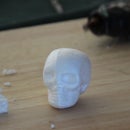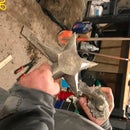Introduction: DIY Vacuum Chamber, What Could Go Wrong
For some time I have wanted to build a vacuum pump and chamber.
The options for uses of these are endless. Vacuum Bagging of composites, Vacuum Impregnation of wood, boiling point experiments, plaster investing for casting to name a selection.
Looking on the internet you will find numerous references to the reuse of a fridge compressor as a compressor, or as a vacuum pump.
Don't expect to win any prizes on the speed of these but my goodness the pressure they can pump and the vacuum they can suck.
Being an environmentally responsible citizen you should first ensure that your compressor is drained of all of the ozone depleting CFC's before 'hacking' into it.
Releasing CFC refrigerant to atmosphere is rather illegal so do heed this warning.
I have read also that heating of these gases with a blowtorch can result in some rather nasty compounds being created.
To prepare my compressor I bought it from an appliance repair man and had him degas it first, it was removed from the fridge already so I had to do little from here.
Be careful that you keep the applicable wiring, you will need the starter circuit. This will often be in a junction box of sorts on the motor.
The oil in a fridge motor is also not meant to be 'nice' therefore I drained it out and replaced it with ordinary compressor oil.
It was then for me as simple as applying a plug to it and powering it up, One tube sucks and one tube blows.
Doesn't win any prizes for speed but you can see how effective it is very quickly when you use it to apply vacuum to a soft drink bottle and suck it right down.
Step 1: The Fail(s)
Wanting the setup to be useful I then went about constructing a vacuum chamber.
I went and purchased some brass fittings, reinforced rubber fuel hose, a vacuum gauge and an aluminium pot to use as a chamber.
Using some brass compression fittings I was quickly, easily and relatively cheaply able to plumb onto the copper pipes coming out of the compressor. I then used a threaded to barbed adaptor to fit the hose on.
Very early on I was able to 'bottom out' my vacuum gauge by shutting off the end of the pipe.
While reinforced fuel line is designed for pressure it is super effective for vacuum also.
Many of you tinkerers will be able to identify, we work with pressure so often and say 100psi seems so familiar to us, we can almost feel the pressure. To this very moment while I have seen the vacuum gauge it does not seem something one can identify with.
You expect vacuum to behave like pressure but surprise surprise it does not. Where pressure will try and find any place it can to escape, vacuum try's to do the same but as it sucks it often seals the leak.
Using a brass fitting I plumbed the rubber hose to the lid of the pot. I purchased a silicone pressure cooker seal to go around the lid to assist with the sealing.
I smeared the seal faces with petroleum jelly then flicked the switch, watching eagerly on the vacuum gauge as the vacuum climbed. Probably I should have been watching the pot instead. I heard a slight creak (should have stopped here but I carried on) then there was a noise that sounded like the cross between a bang and a gulp as the pot imploded.
I should have been disappointed at the failure of this chamber but I understood why it had happened immediately.
Step 2: Version 2, Another Fail.
Back to the drawing board...
A week or 2 later I was back with revision 2, a sturdy 10 litre stainless steel bucket and a 10mm thick piece of Perspex for a lid.
Once again I used a brass fitting to plumb the hose to the Perspex lid.
I had purchased another silicone seal but it did not fit so I applied lots of petroleum jelly as a seal. Firmly pressing on the lid I was able to achieve an airtight seal.
Proudly I yelled to my Wife to come and look at my success. With me in the garage and her in the house she got to the back door before an almighty bang was once again heard and this much more sturdy bucket was imploded.
I appeared at the door of the garage with a crumpled bucket and a grin from ear to ear. (no photo sorry, has already gone in the trash I think)
Once again a fail but once again a learning experience.
I have to be honest, something rather fulfilling about imploding a bucket and a pot.
This project is on the backburner for now and the compressor pump sits on the bench and I have a few ideas as to how to make version 3 work.
It will probably involve the use of a valve in the system to allow me to evacuate a partial vacuum then isolate it. Also the use of a vacuum relief safety device.
Surely some of you out there have had some similar experiences.




